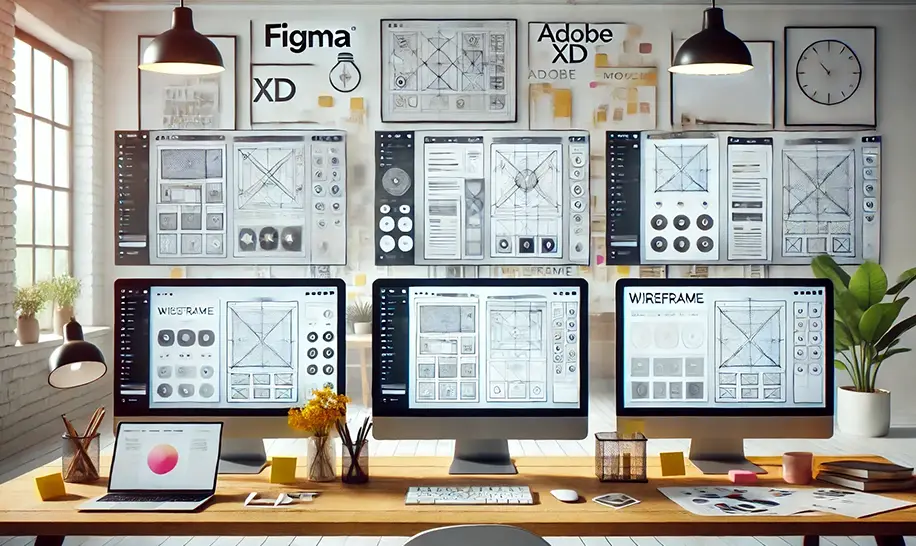
Best 5 Free Wireframe Tools for UI/UX Design & Prototyping.
In the evolving digital landscape, UI/UX designers need agile, intuitive, and versatile tools to translate ideas into seamless user experiences. Wireframing is a cornerstone of this process, allowing teams to draft and iterate on layout, structure, and functionality before progressing to development.
Whether you're designing websites, mobile apps, or SaaS products, selecting the right free wireframing tool can enhance both productivity and creativity. Here are the best 5 free wireframe tools for UI/UX design and prototyping that you can start using right away.
Why Use Free Wireframe Tools for UX/UI Design?
Wireframes are essential for early-stage design, helping you visualize content placement, user journeys, and overall information architecture. By utilizing free wireframe tools, designers can iterate faster, collaborate better, and reduce errors in later stages. They act as a blueprint, ensuring that development aligns perfectly with business goals and user needs.
1. Figma – The Gold Standard for Collaborative UI/UX Design
Download / Access Figma Free Plan
Figma is a web-based design tool that has revolutionized collaborative workflows in the UI/UX community. With its free plan, individual designers and teams can create wireframes, design systems, and interactive prototypes effortlessly. Its intuitive drag-and-drop interface and real-time collaboration feature allow you to co-design, comment, and iterate from any location. Figma also offers a vast ecosystem of plugins and templates, making it one of the most comprehensive free wireframing and prototyping tools today. Designers love its cross-platform capabilities, and it seamlessly integrates with tools like Slack and Jira.
Key Features:
- Real-time collaboration with commenting and editing.
- Drag-and-drop wireframing with reusable UI components.
- Interactive prototyping with transitions and animations.
- Design system management for consistency across projects.
- Plugin ecosystem with tools for icons, mockups, and automation.
2. Lunacy – Free Offline Wireframe & UI Design Software
Lunacy by Icons8 is a robust UI/UX design software that works perfectly offline. It's an advanced vector graphic design app that enables designers to create wireframes, interfaces, and even full prototypes without an internet connection. Lunacy is fully compatible with Sketch files and comes equipped with built-in design assets like icons, illustrations, and photos, saving you tons of time. The tool is highly optimized, offering a smooth and responsive experience even on low-end PCs. For teams preferring desktop solutions, Lunacy is a top contender offering both power and speed.
Key Features:
- Offline access with full functionality (no internet required).
- Built-in assets such as icons, photos, and illustrations.
- Sketch file compatibility for easy cross-platform collaboration.
- AI-powered tools including image upscaling and background removal.
- Fast, responsive performance even on low-spec hardware.
3. Justinmind – All-in-One UX Wireframe & Prototyping Tool
Justinmind is an all-in-one platform for wireframing and prototyping with a focus on user flows and interactions. It allows designers to create highly functional wireframes that can be transformed into realistic, clickable prototypes. Justinmind supports conditional logic, data lists, and dynamic behavior simulations that are ideal for UX-heavy projects. It also features a wide range of pre-built UI kits and integrations with Sketch, Adobe XD, and Figma. Whether you're designing mobile apps, web platforms, or enterprise software, Justinmind enables you to deliver human-centered solutions with ease.
Key Features:
- Drag-and-drop wireframe editor with ready-made UI kits.
- Advanced interactions including conditions and variables.
- Interactive prototypes for realistic testing.
- Integrations with Sketch, Figma, and Adobe XD.
- Collaboration tools with commenting and feedback features.
4. Framer – Interactive Wireframes and Prototypes with Code
Framer is a versatile prototyping tool combining visual design with powerful code-level customization. It's a preferred choice for designers who want to create both static wireframes and dynamic, interactive prototypes. The platform allows for real-time collaboration, drag-and-drop design, and advanced animation features. What makes Framer stand out is its ability to integrate directly with React components, offering developers and designers a shared playground. With its free plan, you can design interactive wireframes and share prototypes effortlessly with stakeholders for instant feedback.
Key Features:
- Interactive prototyping with complex transitions and animations.
- Drag-and-drop interface for easy wireframing.
- React integration to bridge the gap between design and development.
- Real-time multiplayer collaboration and feedback.
- Component libraries to maintain design consistency across projects.
5. Penpot – Open-Source Wireframing & UI Design Tool
Penpot is a free, open-source wireframing and prototyping tool designed for cross-functional teams. It supports SVG and web standards, making it an excellent choice for developers and designers who want more control over their design process. With Penpot, you can create responsive wireframes, interactive prototypes, and UI systems collaboratively in your browser. Its open-source nature allows for community-driven enhancements and customization, making it particularly popular among teams that prioritize open collaboration and transparency. Penpot is also fully browser-based, with no need for software downloads on team machines.
Key Features:
- Open-source architecture for customization and community-driven improvements.
- Browser-based design without installation.
- Responsive wireframing with grid and layout tools.
- Interactive prototyping with linking and transitions.
- Developer-friendly with SVG and CSS export options.
Conclusion: Which Free Wireframe Tool is Best for You?
Choosing the right free UI/UX wireframing tool boils down to your team's workflow, technical requirements, and the complexity of your project. If you need browser-based collaboration, Figma and Penpot are unbeatable. For offline work with powerful asset libraries, Lunacy is a winner. Meanwhile, Framer is ideal for teams that want design-to-code workflows, and Justinmind is perfect for complex UX and interaction design.
Regardless of your choice, these tools empower designers to visualize, iterate, and bring intuitive user experiences to life—without spending a dime.



